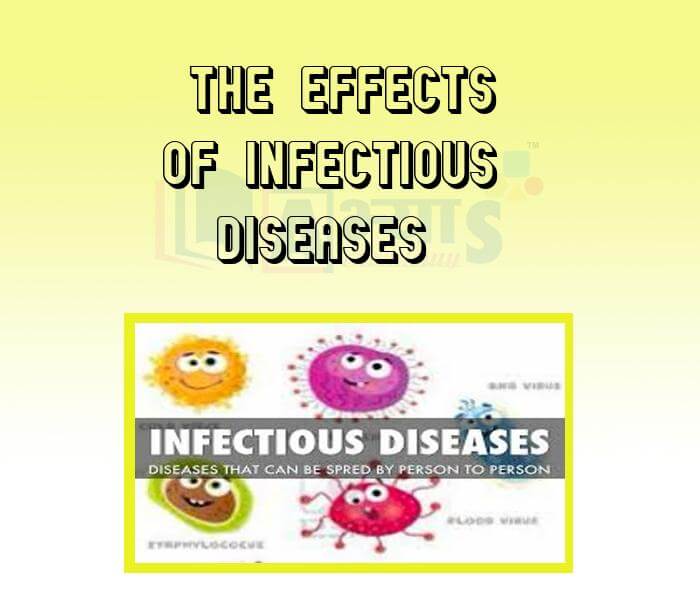Effects of Infectious Diseases













Effects of Infectious Diseases
The Effects of infectious Diseases: the part of the body that gets affected: Infectious agents enter the body through several places. They may enter through the eyes, nose, mouth, cuts and wounds, and through the sexual organs. The part of the body that gets affected may depend on from where the infectious agent enters. For example, the infectious agents which cause conjunctivitis enter the eye and infect it. Infectious agents who enter through the nose affect the organs of the respiratory system. For example, the virus that causes common cold affects the upper respiratory tract, and the bacteria that cause tuberculosis first affects the lungs.
Common effects of infectious diseases: Whenever the body is attacked by infectious agents, the immune system of the body reacts to defend it. This defensive reaction does not depend upon how the infectious agents entered the body, or where it resides inside the body. In all cases, the body’s immune system sends white blood cells to the place where the infectious agents are. To fight the infectious agents, the white blood cells release some chemicals, setting off chemical reactions. The defensive reaction of the body’s immune system in response to infection or injury is called inflammation. Inflammation is characterized by swelling, reddening, and pain in the affected area of the body, plus an increase in body temperature.
Signs, symptoms and effects related to the affected organs and tissues: Certain signs and symptoms of an infectious disease depend upon the tissues or organs that are affected. In tuberculosis, the lungs are affected. So there is coughing and breathlessness. In cholera, the intestine is affected. So the patient has stomach ache and passes loose stools. In hepatitis, the liver is affected, which causes yellowing of the skin. In encephalitis, the brain is affected, which causes headache and giddiness. Sometimes, an infectious disease might affect the body in such a way that wide-ranging effects are produced, which are not confined to any particular organ. For example, HIV (human immunodeficiency virus) which causes AIDS, attacks and affects the immune system of the body. As a result, the body’s ability to fight infections gets weakened. So the patient gets different kinds of diseases like tuberculosis, pneumonia, hepatitis, certain kinds of cancer, etc. These diseases affect different parts of the body.
Severity of the effects: In general, the greater the number of infectious agents in the body, the more severe is the effect of the infection. Infectious agents affect the processes inside our body. As they live and multiply inside the body, they may produce substances that are harmful for us. It is obvious that the greater the number of these organisms, the greater is the ill effect on the body. Also, if the infectious agents are not too many, the immune system and medicines may overcome them easily. However, if the infectious agents are large in number, the immune system and medicines take time to overcome them.
Malaria causing organisms particularly effect which part of a person body ? | |||
| Right Option : D | |||
| View Explanation | |||
Mumps is caused due to the inflammation of _________________ | |||
| Right Option : B | |||
| View Explanation | |||
Japanese encephalitis affects which part of the body ? | |||
| Right Option : B | |||
| View Explanation | |||
Students / Parents Reviews [10]
Abhyas is a complete education Institute. Here extreme care is taken by teacher with the help of regular exam. Extra classes also conducted by the institute, if the student is weak.

Om Umang
10thOne of the best institutes to develope a child interest in studies.Provides SST and English knowledge also unlike other institutes. Teachers are co operative and friendly online tests andPPT develope practical knowledge also.

Aman Kumar Shrivastava
10thMy experience was very good with Abhyas academy. I am studying here from 6th class and I am satisfied by its results in my life. I improved a lot here ahead of school syllabus.

Ayan Ghosh
8thIt has a great methodology. Students here can get analysis to their test quickly.We can learn easily through PPTs and the testing methods are good. We know that where we have to practice

Barkha Arora
10thBeing a parent, I saw my daughter improvement in her studies by seeing a good result in all day to day compititive exam TMO, NSO, IEO etc and as well as studies. I have got a fruitful result from my daughter.

Prisha Gupta
8thMy experience with Abhyas academy is very good. I did not think that my every subject coming here will be so strong. The main thing is that the online tests had made me learn here more things.

Hiya Gupta
8thAbout Abhyas metholodology the teachers are very nice and hardworking toward students.The Centre Head Mrs Anu Sethi is also a brilliant teacher.Abhyas has taught me how to overcome problems and has always taken my doubts and suppoeted me.

Shreya Shrivastava
8thIt was good as the experience because as we had come here we had been improved in a such envirnment created here.Extra is taught which is beneficial for future.

Eshan Arora
8thMy experience with Abhyas is very good. I have learnt many things here like vedic maths and reasoning also. Teachers here first take our doubts and then there are assignments to verify our weak points.

Shivam Rana
7thI have spent a wonderful time in Abhyas academy. It has made my reasoning more apt, English more stronger and Maths an interesting subject for me. It has given me a habbit of self studying
